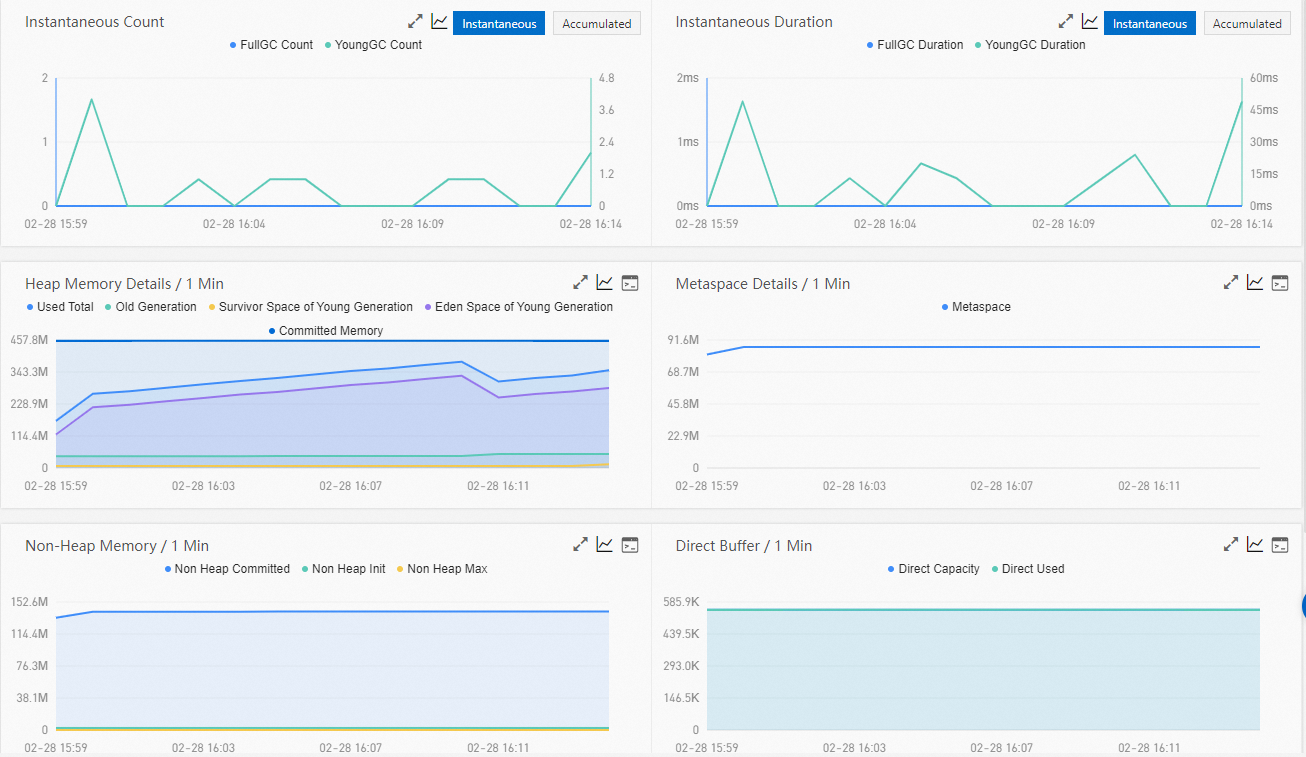The Java Virtual Machine (JVM) monitoring feature allows you to monitor key JVM metrics, such as metrics related to instantaneous garbage collections (GCs), heap memory, non-heap memory, metaspace, direct buffer, and JVM threads. This topic describes the JVM monitoring feature and shows you how to view the JVM metrics.
Procedure
Log on to the ARMS console. In the left-side navigation pane, choose .
On the Applications page, select a region in the top navigation bar and click the name of the application that you want to manage.
NoteIf the
 icon is displayed in the Language column, the application is connected to Application Monitoring. If a hyphen (-) is displayed, the application is connected to Managed Service for OpenTelemetry.
icon is displayed in the Language column, the application is connected to Application Monitoring. If a hyphen (-) is displayed, the application is connected to Managed Service for OpenTelemetry. In the left-side navigation pane, click Application Details.
On the Application Details page, click the instance that you want to view in the left-side pane, and then click the JVM monitoring tab on the right side.

View the JVM metrics
On the JVM monitoring tab, you can view the time series curves for the number of instantaneous GCs, time consumed for instantaneous GCs, heap memory details, metadata details, non-heap memory details, direct buffer details, and number of JVM threads.
You can click Instantaneous or Accumulated in the upper-right corner of the Instantaneous Count and Instantaneous Duration charts to switch between different curves. You can view the time series curves for the quantities of instantaneous GCs and accumulated GCs, and time consumed for instantaneous GCs and accumulated GCs.
You can click the name of a metric such as FullGC Count on a chart to show or hide the metric.
NoteEach chart must contain at least one visible metric. If only one metric is displayed in a chart, you cannot hide the metric.
Click the
 icon on each chart to view the statistics of the metric in a specific time period or compare the statistics of the metric in the same time period on different days.
icon on each chart to view the statistics of the metric in a specific time period or compare the statistics of the metric in the same time period on different days. You can click the View API icon in the upper-right corner of the Heap Memory Details / 1 Min, Metadata Details / 1 Min, Non-Heap Memory / 1 Min, Direct Buffer / 1 Min, and JVM Threads / 1 Min charts to view the detailed information about the APIs that are related to the metrics.
Metrics
The JVM monitoring feature can be used to monitor the following metrics:
Instantaneous and accumulated GC details
Number of full heap GCs (full GCs)
Number of GCs in the young generation
Time consumed for full GCs
Time consumed for GCs in the young generation
Heap memory details
Total heap memory
Amount of heap memory in the old generation in bytes
Amount of heap memory in the young generation (survivor space) in bytes
Amount of heap memory in the young generation (eden space) in bytes
Metaspace details
Size of metaspace in bytes
Non-heap memory details
Maximum amount of non-heap memory in bytes
Amount of used non-heap memory in bytes
Direct buffer details
Total direct buffer in bytes
Used direct buffer in bytes
JVM thread details
Total number of threads
Number of deadlocked threads
Number of new threads
Number of blocked threads
Number of runnable threads
Number of terminated threads
Number of threads in the timed waiting state
Number of waiting threads
References
The data collected by Application Monitoring comes from Java Management Extensions (JMX), excluding some non-heap memory areas of Java processes. Therefore, the sum of heap and non-heap memory displayed in Application Monitoring differ greatly from the Resident Memory Size in KiB (RES) queried by running the top command. For more information, see JVM memory details.